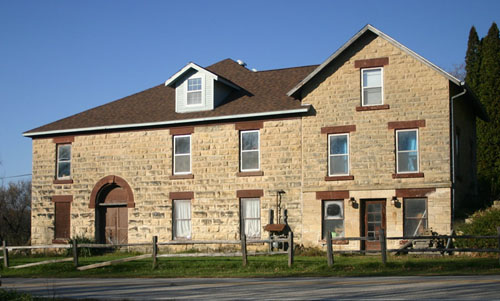Rick’s Brewery is locally significant under criterion C as one of the few remaining examples of early Iowan industry in the Anamosa area. Originally constructed prior to 1859, the stonework with minor exceptions appears exactly as it did when the last addition was completed in 1872. Building materials came from a local quarry and sawmill, businesses that were already established by this time. Further research conducted by contacting Randy Carlson, author of “The Breweries of Iowa, Bemidji, Minn.: Arrow Printing,1985”, has shown that this brewery site represents a design of German origins. Mr. Carlson has in his possession a book printed in Germany in the 1800’s that describes how to build a brewery. During a telephone conversation from his residence in Minnesota, Mr. Carlson was able to conduct a virtual tour of this brewery site using that reference work. Rick himself emigrated from Germany around 1847. Immigrant stone cutters and masons were responsible for the buildings construction. The hillside location with a creek in close proximity was chosen by design for optimum brewery operation, just like early mills were built near water power.
This is one of the few small home breweries built in the late 1850’s left in Iowa. In 1878 there were 132 breweries recorded as operating in Iowa, many of these had a very limited output and few were initially constructed as breweries. In the last years of operation Rick’s Brewery produced 500 barrels per year. For reference, there were two large operations in Cedar Rapids, twenty miles to the west, which had production over 3000 barrels per year.
The brewing process is very complex and time consuming. Mashing, boiling, and aging temperatures all had very critical limits. All of these main brewery function areas are still represented here. Grain and other supplies were stored in the attic/loft. Grinding and mashing took place on the second floor. Boiling and cooling on the first floor, and fermenting was done in the now collapsed aging tunnels. Cleansing and racking was done in the small stone shed usually built apart from the main brewery for that purpose. The racking process was dangerous due to the fire hazard when the barrels/kegs were charred, then pitched inside with tar. The building was constructed into the side of a hill to provide easy access to aging tunnels, other breweries often used caves. A creek ran through the property providing necessary cooling water. Proper filtering methods were vital for maintaining a quality output, and necessary to produce the maximum output for a given amount of grain. It can take up to 10 weeks from start to finish to produce a barrel of beer. By this description you can see that Rick’s Brewery was a very sophisticated engineering feat for this locale at that time.
The brewing industry in Iowa went through many different prohibition periods. Iowa had prohibition from 1855 to 1857, 1882 to 1883, 1884 to 1894, and finally from 1917 to 1933. With operation dates from 1859 until 1878, Kohl and Rick operated their brewery within a window of opportunity. Generally Eastern Iowa wasn’t effected greatly by these prohibition periods. However, Anamosa contained a strong pocket of prohibitionists. It was said that one of these individuals was Colonel Shaw. It was from pressure by these men that Anamosa remained a dry town through most of these years. This certainly had something to do with why the brewery property was just outside of the Anamosa city limits. Thebrewery did have a retail sales tax certificate at the time it was sold in 1878, so one could assume they were also selling beer to the public. In spite of the government regulation and local municipal opposition, Rick’s Brewery operated for 20 years. During that time it was rumored to be a meeting place for the townsmen that the prohibitionists had dried up with the town. It is also rumored that even long after that time owners of the “old brewery” still continued to brew their own private stock and entertain friends “regularly”.
Historical archaeological potential may be present in different areas around the site pertaining to the original operations of the brewery. These include tunnel ruins, remains of other outbuildings, possible waterworks, and other artifacts. While digging a shallow drainage trench along the North side of the building in August of 1991, evidence of the underground tunnels were uncovered. These were build in 1872, when the building expansion was done. Later in 1995, when doing additional drainage work directly north of the original 1857 structure, the remains of the original aging tunnel walls were found. A large hand dug, stone lined well that dates back to the 1870’s can be found near the west side of the building. This well was likely used in place of the creek to provide necessary cooling for the brew. It has a diameter of nearly five feet. The old kettle room has a wooden floor. Removal of one loose board revealed several very old bottles underneath. When digging a post hole twenty feet north of the 1872 addition, limestone footings were discovered that were likely from a stable or similar structure.

